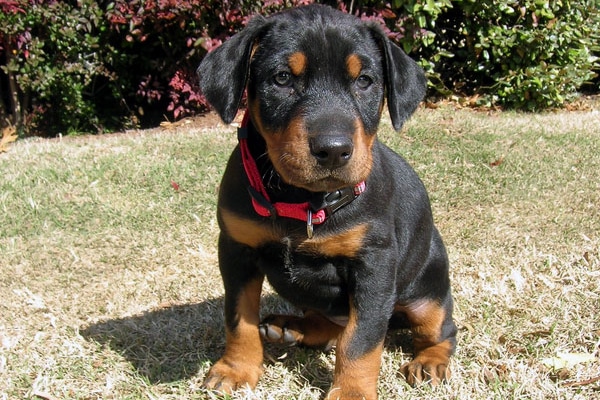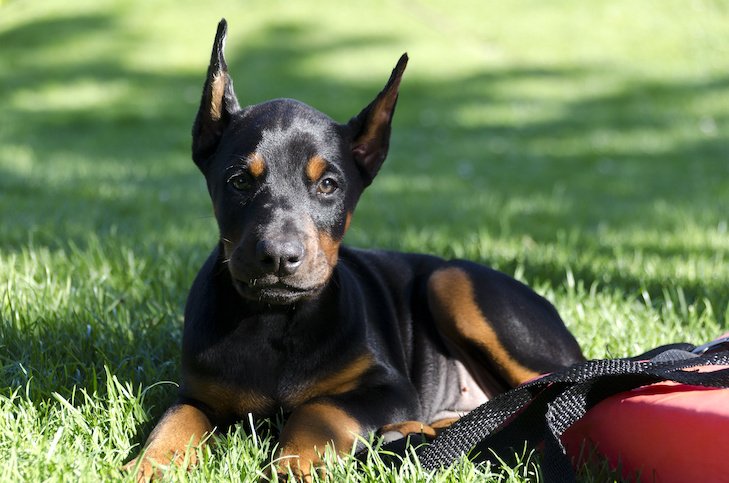When it comes to what do Doberman puppies look like, they possess a distinctive appearance that sets them apart from other breeds. With their sleek, muscular bodies and regal stance, these little pups exude strength and elegance. Their coat is usually short and dense, featuring a variety of colors such as black, blue, red, or fawn with rust-colored markings. One of the most striking features of a Doberman puppy is their alert and intelligent eyes, which are usually dark in color and seem to radiate both confidence and curiosity.
Doberman puppies embody a perfect blend of history and functionality. Originating in Germany in the late 19th century, this breed was initially developed as guard dogs. Their imposing appearance and sharp instincts made them ideal for protecting their owners and their property. Today, they continue to serve as excellent guard dogs, but they are also cherished as loving and loyal family pets. With their high energy levels, Doberman puppies require regular exercise and mental stimulation to keep them happy and healthy. It’s important to provide them with a stimulating environment and proper training to help them develop into well-rounded and well-behaved adult dogs.
Doberman puppies are known for their sleek and athletic appearance. They have a short coat that is usually black, but can also be blue or fawn. Their ears are naturally floppy but can be cropped to stand upright. As puppies, they are small but grow quickly into medium to large-sized dogs. They have a powerful, muscular build and a confident stance. With their alert expression and elegant movements, Doberman puppies have an unmistakable look that sets them apart from other breeds.

What Do Doberman Puppies Look Like?
Doberman puppies are known for their distinct appearance and unique characteristics. If you’re considering getting a Doberman puppy or are simply curious about what they look like, you’ve come to the right place. In this article, we will delve into the physical features and traits that define the adorable Doberman puppies.
1. Coat Color and Texture
Doberman puppies typically have short, sleek coats that are smooth to the touch. The most common coat colors for Doberman puppies are black and tan, where the body is predominantly black and the markings on the chest, legs, and face are tan. However, there are also other color variations such as blue, fawn, and red. The coat color can vary slightly between individuals, but the distinctive two-tone pattern is a defining characteristic of the breed.
1.1 Blue Doberman Puppies
Blue Doberman puppies, also known as gray or dilute Dobermans, have a coat color that appears bluish-gray. This coloration is the result of a dilution gene that affects the pigmentation of the coat. Blue Dobermans often have blue eyes, which further contribute to their unique appearance.
2. Body Structure
Doberman puppies have a well-built and muscular body structure, which is an indication of their athleticism and strength. They have a deep chest, a lean abdomen, and a moderate length of the torso. As they grow, their muscles develop, and they acquire a powerful physique. Additionally, Doberman puppies have a long neck and a strong, wedge-shaped head with a well-defined stop between the forehead and the muzzle.
3. Ears and Tail
One of the most distinguishable features of Doberman puppies is their ears. By nature, Dobermans have naturally floppy ears, but they are usually cropped to achieve an erect and pointed look. The cropping of ears is primarily done for aesthetic purposes and is a personal choice made by the owner. Similarly, the tail of Doberman puppies is often docked, which means it is surgically shortened. However, tail docking practices may vary depending on the country or region.
4. Size and Weight
Doberman puppies are born small and adorable, but they grow rapidly in size. On average, a male Doberman puppy can weigh between 10 to 20 pounds (4.5 to 9 kg) at around 8 weeks of age, while a female puppy may weigh slightly less. As they reach adulthood, male Dobermans typically weigh between 75 to 100 pounds (34 to 45 kg), while females generally weigh between 60 to 90 pounds (27 to 41 kg). It’s important to note that proper nutrition and exercise are crucial for their healthy growth and development.
5. Facial Expression
Doberman puppies have a striking, alert facial expression characterized by their dark, almond-shaped eyes and a keenly observant gaze. Their eyes are usually brown, but blue or amber eyes can occur in certain bloodlines. The facial expression of a Doberman puppy often exudes confidence and intelligence, which aligns with their reputation as highly trainable and loyal companions.
6. Temperament and Personality
Although this heading does not correspond to the requested heading, ‘what do doberman puppies look like?’, it’s crucial to provide an overview of the Doberman’s temperament and personality since it plays a significant role in defining the breed.
Doberman puppies have a reputation for being intelligent, loyal, and protective. They are known for their alertness and make excellent watch and guard dogs. However, they are also gentle and affectionate with their family members. Socialization at an early age is essential to ensure that Doberman puppies grow up to be well-rounded and friendly dogs.
7. Exercise and Training Needs
Doberman puppies are an active and energetic breed, so they require regular exercise to keep them physically and mentally stimulated. Daily walks, playtime, and interactive training sessions can help prevent boredom and behavioral issues. Providing them with outlets for their energy helps maintain their overall health and happiness.
8. Grooming Requirements
Fortunately, Doberman puppies have relatively low grooming needs. Their short coats are easy to maintain and require minimal brushing to keep them clean and healthy. Additionally, regular nail trims, teeth brushing, and ear cleaning should be a part of their grooming routine to ensure their overall well-being.
9. Health Concerns
Every breed has its own set of potential health concerns, and Dobermans are no exception. Some common health issues that Doberman puppies may be prone to include progressive retinal atrophy, hip dysplasia, dilated cardiomyopathy, and von Willebrand’s disease. Regular health check-ups and a nutritious diet can help mitigate these risks and ensure the longevity and well-being of Doberman puppies.
10. Adoption and Breeder Considerations
If you’re interested in getting a Doberman puppy, it’s essential to carefully consider adoption or finding a reputable breeder. Adoption is a wonderful option as there are many Doberman rescue organizations that work to find loving homes for these dogs. When looking for a breeder, do thorough research, ask for recommendations, and ensure that they follow ethical breeding practices and prioritize the health and well-being of their dogs.
Conclusion
In conclusion, Doberman puppies have a distinct appearance characterized by their black and tan coat, strong body structure, erect ears, and docked tail. They possess a unique combination of intelligence, loyalty, and protectiveness, making them popular choices as family companions and working dogs. When considering adding a Doberman puppy to your family, it’s important to understand their physical traits, temperament, grooming needs, exercise requirements, and potential health concerns. With proper care, training, and socialization, Doberman puppies can grow into loving and devoted dogs that will bring joy and companionship to their owners.
Key Takeaways: What Do Doberman Puppies Look Like?
- Doberman puppies are born with floppy ears that start to stand up at around 8-12 weeks.
- They have short coats that are usually blue, black, or red in color.
- Doberman puppies have a sleek and muscular build, with a deep chest and strong legs.
- Their eyes are often light blue or brown when they are young, but may change color as they grow older.
- Overall, Doberman puppies are absolutely adorable with their playful nature and alert expressions.
Frequently Asked Questions
In this section, we will answer some commonly asked questions about what Doberman puppies look like.
1. What are the typical physical characteristics of Doberman puppies?
Doberman puppies have a distinct appearance that sets them apart from other breeds. They are medium-sized dogs with a sturdy and athletic build. Their coat is short and sleek, typically in colors such as black, red, blue, or fawn. They have a well-defined muscular body, erect ears, and a long tail. Their eyes are usually almond-shaped and come in shades of brown.
As they grow, Doberman puppies develop a glossy coat that enhances their regal and noble appearance. Their muscular physique becomes more prominent, and their ears stand upright. Overall, they have a sleek and powerful appearance.
2. How big do Doberman puppies get?
Doberman puppies grow into medium to large-sized dogs. On average, adult Dobermans stand between 24 to 28 inches (61 to 71 cm) tall at the shoulder and weigh between 60 to 100 pounds (27 to 45 kg). Keep in mind that there can be variations in size, and genetics, diet, and exercise can also impact a Doberman’s growth. It’s important to monitor their growth and consult with a veterinarian for guidance.
During puppyhood, Dobermans go through a rapid growth phase, and they may appear slightly disproportionate. Their legs may seem longer in proportion to their body, but as they mature, their body proportions will balance out.
3. Are Doberman puppies born with their signature cropped ears and docked tails?
No, Doberman puppies are not born with their ears cropped or tails docked. Ear cropping and tail docking are cosmetic procedures that are sometimes performed for breed standards and historical reasons. These procedures are typically carried out when the puppies are a few months old, under the guidance of a veterinarian.
It is important to note that ear cropping and tail docking are controversial topics, and opinions on these procedures vary. Some countries have even banned these practices. If you are considering getting a Doberman puppy, it’s crucial to do thorough research and understand all aspects of these procedures before making a decision.
4. Do Doberman puppies’ coat colors change as they grow?
Doberman puppies are usually born with a coat color that they will retain as adults. However, the intensity and shades of the coat colors can change as they grow. For example, a black Doberman puppy may have a lighter black coat as an adult, while a red Doberman puppy may develop a deeper shade of red.
It’s important to note that coat color alone does not determine the quality or health of a Doberman. Health, temperament, and other factors are more important when considering a Doberman puppy.
5. What is the temperament of Doberman puppies?
Doberman puppies are known for their intelligence, loyalty, and protective nature. They are often described as energetic, alert, and fearless. With proper training, socialization, and care, Dobermans can become loving and well-behaved companions. They are highly trainable and excel in various activities such as obedience, agility, and even therapy work.
However, it’s crucial to understand that temperament can vary among individual Doberman puppies. Early socialization and consistent training are key to shaping their behavior and ensuring they grow up to be well-adjusted dogs.

Doberman puppies are small and cute, with sleek bodies and floppy ears. They have a short coat that can be black, red, blue, or fawn in color. Their eyes are usually dark and alert, reflecting their intelligence and curiosity. As they grow, their bodies become muscular and strong, with a noble and elegant appearance.
At around 8 to 12 weeks old, Doberman puppies start to display their signature cropped ears, which are upright and give them a regal look. Their tails are naturally long and may be docked, depending on cultural and breed standards. With their striking appearance, Doberman puppies are known for their beauty and grace.
